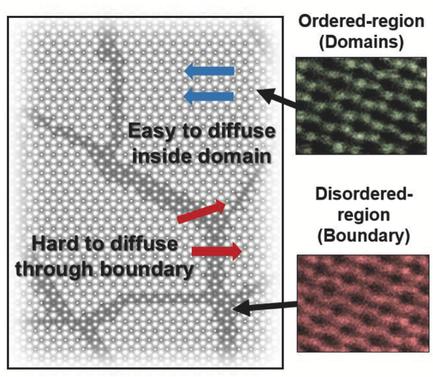当前位置:
X-MOL 学术
›
Adv. Energy Mater.
›
论文详情
Our official English website, www.x-mol.net, welcomes your feedback! (Note: you will need to create a separate account there.)
Intrinsic Nanodomains in Triplite LiFeSO4F and Its Implication in Lithium‐Ion Diffusion
Advanced Energy Materials ( IF 27.8 ) Pub Date : 2017-10-12 , DOI: 10.1002/aenm.201701408 Dong-Hwa Seo 1 , Kyu-Young Park 1, 2 , Haegyeom Kim 1 , Sung-Kyun Jung 1, 2 , Min-Sik Park 3 , Kisuk Kang 1, 2
Advanced Energy Materials ( IF 27.8 ) Pub Date : 2017-10-12 , DOI: 10.1002/aenm.201701408 Dong-Hwa Seo 1 , Kyu-Young Park 1, 2 , Haegyeom Kim 1 , Sung-Kyun Jung 1, 2 , Min-Sik Park 3 , Kisuk Kang 1, 2
Affiliation

|
Triplite‐type LiFeSO4F has attracted considerable attention as a promising cathode for next‐generation lithium‐ion batteries because of its high redox potential based on earth‐abundant Fe2+/3+. However, successful extraction/reinsertion of all the lithium ions in triplite host is challenging even at a low current rate, resulting in a low specific capacity. These experimental findings contrast with previous theoretical works that predicted that the triplite structure would be a fast ionic conductor with low activation barriers for lithium‐ion hopping. Origin of this discrepancy is elusive to date. Herein, combined first‐principles calculations and high‐angle annular dark‐field scanning transmission electron microscopy analyses reveal that typical triplite structure is composed of nanodomains consisting of corner‐shared FeO4F2 octahedra, whereas their domain boundaries are regions of mixed corner/edge‐shared FeO4F2 octahedra. More importantly, these locally disordered domain boundaries significantly reduce the overall lithium diffusivity of the materials. Inspired by these findings, this study redesigns triplite structure with sufficiently small sizes to avoid local bottlenecks arising from the domain boundaries, successfully achieving nearly full lithium extraction/reinsertion with high power and energy density. This work represents the first direct observation of the presence of domain boundaries within a crystalline structure playing a critical role in governing the lithium diffusivity in a battery electrode.
中文翻译:

三重晶LiFeSO4F的内在纳米域及其在锂离子扩散中的意义
Triplite型LiFeSO 4 F作为下一代锂离子电池的有希望的正极已经引起了相当大的关注,因为它具有基于地球丰富的Fe 2 + / 3 +的高氧化还原电势。然而,即使在低电流速率下,成功地提取/重新插入三重晶基质中的所有锂离子也具有挑战性,导致比容量低。这些实验结果与先前的理论工作相反,先前的理论工作预言三重结构将是具有低活化势垒的快速离子导体,对锂离子跳跃而言。迄今为止,这种差异的起源还难以捉摸。在这里,结合第一性原理计算和高角度环形暗场扫描透射电子显微镜分析发现,典型的三重晶结构是由角共享FeO 4 F 2八面体组成的纳米域组成的,而它们的域边界是混合角/边缘共享的FeO 4 F 2八面体。更重要的是,这些局部无序的畴边界显着降低了材料的整体锂扩散率。受这些发现的启发,本研究重新设计了具有足够小尺寸的三重晶石结构,以避免由于磁畴边界产生局部瓶颈,从而成功实现了具有高功率和能量密度的近乎完全的锂提取/重新插入。这项工作代表了对晶体结构内畴边界的存在的首次直接观察,该结构在控制电池电极中锂的扩散率中起着至关重要的作用。
更新日期:2017-10-12
中文翻译:

三重晶LiFeSO4F的内在纳米域及其在锂离子扩散中的意义
Triplite型LiFeSO 4 F作为下一代锂离子电池的有希望的正极已经引起了相当大的关注,因为它具有基于地球丰富的Fe 2 + / 3 +的高氧化还原电势。然而,即使在低电流速率下,成功地提取/重新插入三重晶基质中的所有锂离子也具有挑战性,导致比容量低。这些实验结果与先前的理论工作相反,先前的理论工作预言三重结构将是具有低活化势垒的快速离子导体,对锂离子跳跃而言。迄今为止,这种差异的起源还难以捉摸。在这里,结合第一性原理计算和高角度环形暗场扫描透射电子显微镜分析发现,典型的三重晶结构是由角共享FeO 4 F 2八面体组成的纳米域组成的,而它们的域边界是混合角/边缘共享的FeO 4 F 2八面体。更重要的是,这些局部无序的畴边界显着降低了材料的整体锂扩散率。受这些发现的启发,本研究重新设计了具有足够小尺寸的三重晶石结构,以避免由于磁畴边界产生局部瓶颈,从而成功实现了具有高功率和能量密度的近乎完全的锂提取/重新插入。这项工作代表了对晶体结构内畴边界的存在的首次直接观察,该结构在控制电池电极中锂的扩散率中起着至关重要的作用。



























 京公网安备 11010802027423号
京公网安备 11010802027423号